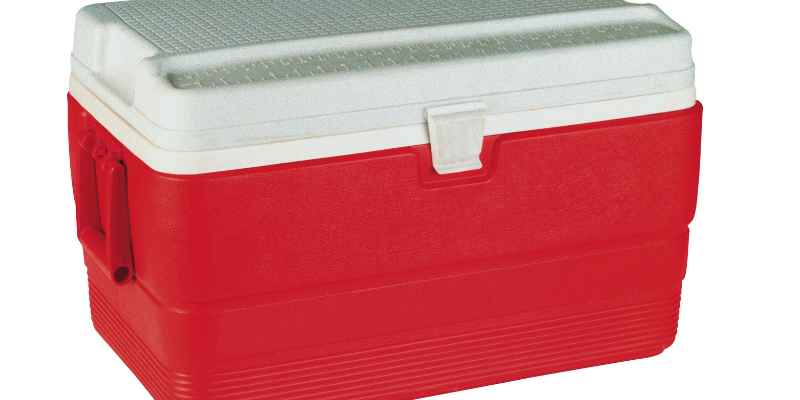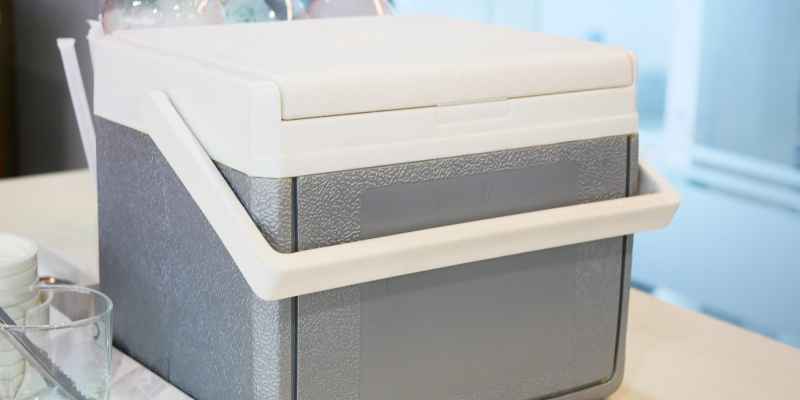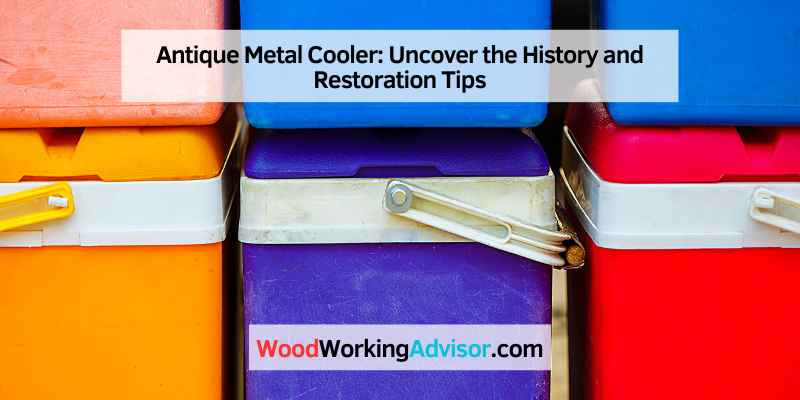An antique metal cooler is a vintage item used for keeping beverages cold. This article explores the history, uses, and popularity of these coolers, as well as tips for identifying and purchasing authentic pieces.
Whether you are a collector or simply appreciate the aesthetic appeal of antique metal coolers, understanding their background and value can enhance your enjoyment of these unique items. From their origins in the early 20th century to the diverse range of styles and designs available today, antique metal coolers offer a blend of nostalgia and practicality.
So, let’s dive into the fascinating world of antique metal coolers.
The History Of Antique Metal Coolers
Antique metal coolers have a rich history dating back to the early 20th century, when they were first introduced to keep beverages cold in various social settings.
Origins And Evolution
The origins of antique metal coolers can be traced back to the industrial revolution era. Companies started producing sturdy metal containers with insulated interiors to preserve the temperature of drinks.
Popularity And Common Uses
- Antique metal coolers gained popularity during the mid-20th century for outdoor gatherings, picnics, and camping trips.
- They were commonly used for storing beverages such as sodas, beers, and fruit juices.
Antique metal coolers are not only functional but also serve as decorative pieces, adding a touch of nostalgia to modern settings.

Types Of Antique Metal Coolers
When it comes to antique metal coolers, collectors and enthusiasts are always on the lookout for unique and rare pieces. These vintage cooling devices not only have a practical function but also serve as charming decor pieces. If you are interested in antique metal coolers, it’s important to familiarize yourself with the different types available. Let’s explore the varieties of antique metal coolers, including the materials used and the distinct styles and designs.
Different Materials Used
Antique metal coolers were made using various materials, each with its own characteristics and charm. Here are some of the materials commonly used:
- 1. Galvanized Steel: This material is known for its durability and resistance to rust and corrosion. Galvanized steel coolers are often found in industrial or military-style designs.
- 2. Aluminum: Lightweight and easy to clean, aluminum coolers were popular during the mid-20th century. They often feature sleek designs and shiny finishes.
- 3. Tin: Tin coolers were common in the 19th and early 20th centuries. They have a vintage charm and are often adorned with colorful graphics or hand-painted designs.
Distinct Styles And Designs
Antique metal coolers come in a wide range of styles and designs, reflecting the trends and tastes of different eras. Here are some of the distinct styles you may come across:
- Art Deco: With sleek lines and geometric patterns, Art Deco metal coolers embody the elegance of the 1920s and 1930s.
- Mid-Century Modern: Coolers from the 1950s and 1960s often feature vibrant colors and futuristic designs, inspired by the Space Age.
- Retro Vintage: These coolers mimic the styles of the past, evoking nostalgia with their retro colors and retro-inspired designs.
Whether you are a collector, decorator, or simply appreciate the beauty of antique metal coolers, exploring the various types can be a fascinating journey. Each piece has its own story and character, making it a unique addition to any collection or home decor.
Identifying And Evaluating Antique Metal Coolers
If you’re a collector or enthusiast of vintage items, you may have come across antique metal coolers. These unique pieces not only add character to any space but also hold historical value. Identifying and evaluating antique metal coolers requires a keen eye for detail and an understanding of their key features, condition, and value.
Key Features To Look For
When identifying antique metal coolers, certain key features can help determine their authenticity and value. Look for manufacturers’ marks or logos, which can provide insight into the cooler’s origin and age. Additionally, examine the construction and materials used, as older coolers are often made of sturdy metal such as galvanized steel or aluminum, and may feature intricate embossing or decorative elements.
Assessing Condition And Value
Assessing the condition of an antique metal cooler is crucial in determining its value. Look for signs of rust, dents, or excessive wear, as these factors can significantly impact the cooler’s value. Inspect the functionality of any included components, such as latches, handles, and drainage plugs. Furthermore, consider the rarity and historical significance of the cooler, as these aspects can also influence its overall worth.
Restoration Techniques For Antique Metal Coolers
Restoration of antique metal coolers is a labor of love and a journey into the past. These coolers exude timeless charm, and restoring them to their former glory requires careful attention to detail and the use of proper techniques. In this guide, we’ll explore restoration techniques for antique metal coolers, including cleaning and removing rust, as well as repairing dents and scratches.
Cleaning And Removing Rust
One of the crucial steps in restoring an antique metal cooler is the thorough cleaning and removal of rust. Begin by wiping the cooler with a damp cloth to remove surface dirt and grime. Next, use a mixture of mild dish soap and water to clean the cooler, ensuring all areas are addressed. For stubborn rust, a mixture of vinegar and baking soda can be applied and gently scrubbed with a soft-bristled brush. Finally, buff the cooler with a polishing agent to restore its shine.
Repairing Dents And Scratches
When restoring an antique metal cooler, repairing dents and scratches is essential in preserving its aesthetic appeal. Small dents can often be repaired using a rubber mallet and gentle taps from the inside of the cooler. For deeper dents, consider seeking professional assistance to ensure precision and preservation. Scratches can be buffed out using metal polish, applied with a soft cloth in a circular motion until the surface is smooth and uniform.
Preserving The Authenticity Of Antique Metal Coolers
Antique metal coolers are not just functional; they are pieces of history that tell a story. Preserving their authenticity is an important aspect of their value. Whether you own an antique metal cooler or plan to invest in one, understanding how to maintain its originality is crucial. In this article, we will explore two key factors that contribute to preserving the authenticity of antique metal coolers: maintaining the original patina and replacing parts with authentic materials.
Maintaining Original Patina
One of the most captivating features of antique metal coolers is their patina – the natural aging process that adds character and charm to the surface. Maintaining the original patina is essential to preserving the authenticity of these coolers. Here are a few tips:
- Avoid using harsh chemical cleaners that can strip away the patina.
- Gently clean the cooler with a mild soap and water solution, using a soft cloth or sponge.
- Regularly apply a thin coat of wax or polish to protect the surface and enhance the patina.
Replacing Parts With Authentic Materials
Over time, antique metal coolers may need parts replacement due to wear and tear. When it comes to preserving authenticity, using authentic materials for replacements is crucial. Here’s what you need to consider:
- Research the original materials used in the cooler and find suppliers that offer authentic alternatives.
- Consult with experts or restoration professionals who specialize in antique metal coolers to ensure accuracy.
- If you cannot find authentic materials, consider restoring damaged parts instead of replacing them entirely.
Preserving the authenticity of antique metal coolers requires both care and attention to detail. By maintaining the original patina and replacing parts with authentic materials, you can ensure that these timeless treasures continue to captivate and delight for generations to come.
Displaying And Using Antique Metal Coolers
In Home Decor
Antique metal coolers can add character to your space as unique decorative elements.
As Functional Beverage Coolers
Repurpose these coolers to use as functional and stylish beverage coolers.
Tips For Buying And Selling Antique Metal Coolers
When searching for antique metal coolers, follow these tips to ensure a successful buying or selling experience. Discover essential considerations for evaluating the condition, age, authenticity, and value of antique metal coolers to make informed decisions in the marketplace.
Where To Find Authentic Pieces
Antique metal coolers can be found at auctions, estate sales, flea markets, and online marketplaces.
Look for reputable antique shops or dealers specializing in vintage items for authentic pieces.
Negotiating Prices And Values
When negotiating, research the market value of the antique metal cooler to ensure a fair price.
Consider the condition, rarity, and historical significance when determining value.
Be prepared to negotiate based on the seller’s asking price and any imperfections in the cooler.
Conclusion And Future Trends
As we conclude our exploration of antique metal coolers, it’s important to consider their place in modern settings and the future trends associated with these timeless pieces.
Appreciating The Craftsmanship
Antique metal coolers are not just functional items; they are an embodiment of exceptional craftsmanship. The intricate designs and attention to detail speak volumes about the dedication of the artisans who created these pieces. Each cooler tells a story of the past, showcasing the skills and artistry that prevailed in bygone eras. The durability and lasting quality of these coolers are a testament to the superior craftsmanship that has stood the test of time.
Antique Metal Coolers In Modern Settings
In contemporary environments, antique metal coolers bring a touch of nostalgia and sophistication. Whether used as unique decor pieces or as fully functional coolers, they add a distinctive charm to any setting. With the resurgence of vintage aesthetics in interior design, antique metal coolers are finding their place in modern homes, restaurants, and event venues. Their ability to seamlessly blend with diverse decor styles makes them versatile assets in today’s design trends.

Frequently Asked Questions Of Antique Metal Cooler
What Are The Benefits Of Owning An Antique Metal Cooler?
An antique metal cooler adds a touch of vintage charm to any space. It provides excellent insulation, keeping drinks cold for extended periods. Additionally, it makes a stylish and unique conversation piece for gatherings and events, elevating the overall atmosphere.
How Can I Maintain The Condition Of An Antique Metal Cooler?
To maintain an antique metal cooler’s condition, regular cleaning with a mild detergent is recommended. Ensure thorough drying to prevent rust and corrosion. A periodic application of metal polish can help retain its luster. Store it in a dry place when not in use to prevent deterioration.
What Factors Should I Consider When Purchasing An Antique Metal Cooler?
When purchasing an antique metal cooler, consider its size, condition, and authenticity. Look for any signs of rust, dents, or damage. Ensure that the cooler’s hardware is intact and functional. Additionally, verify its authenticity through markings or documentation for its value and historical significance.
Conclusion
The antique metal cooler is a unique and charming addition to any outdoor gathering or event. Its vintage design and durable construction make it not only a functional cooler but also a conversation piece. From its superior cooling capabilities to its timeless aesthetics, this cooler is sure to impress.
Whether you’re hosting a backyard barbecue or heading out on a camping trip, the antique metal cooler is a must-have item for any outdoor enthusiast. So, why settle for ordinary when you can add a touch of nostalgia and sophistication with this timeless piece?


